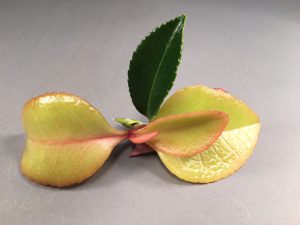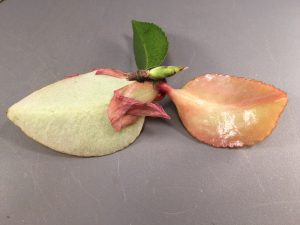Cool, Wet Spring Favors Azalea and Camellia Leaf Gall
Do you have azaleas or camellias with leaves that are thickened, curled and waxy in appearance? This is fairly common this year and is caused by a fungus.

Camellia leaf gall on Sasanqua Camellia. Note swollen, malformed leaves. Photo credit: Larry Williams
Exobasidium vaccinii is a fungus that causes leaves, and in some cases flower petals, to enlarge abnormally and is commonly referred to as azalea leaf and flower gall.
Infected azalea and camellia leaves become large and distorted. Eventually a white powder covers the galls. The white growth consists of spores, which is how the fungus reproduces. Galls ultimately turn brown and harden. Not every leaf will be infected.
The disease relies on airborne spores produced in the whitish mold on the surface of galls in late spring to early summer to reproduce. Some plant pathologists believe that once the spores are released, they are blown and washed to leaf and flower buds where they cause new infections. Galls then form the following spring. Other plant pathologists think that the spores are produced the following year from the old dried, brown galls that fell to the ground around infected plants the previous year. In spring, the spores blow and splash onto new leaves and petals as they emerge causing infection. One or both lines of thought may be true. But in either case, it’s important to remove and dispose of infected leaves before they turn white with spores.
Once you see evidence of infected leaves, it’s too late for chemical control. Besides, there currently is no effective or practical fungicide to control this disease in home landscapes. But you can reduce the amount of infection the following year by pruning infected leaves and throwing them away before spores develop. After removing infected leaves with galls, never leave them on the ground around the plants.
It’s best to bury, burn or place infected leaves in a plastic bag and throw them away. This disease is more severe during a cool, wet spring, which we experienced this year. It’s advisable to not add to the problem by artificially providing the “wet weather” the spores need by frequently using an overhead sprinkler and keeping the foliage wet in the spring during disease development. This is exactly what this and many other plant diseases need – wet conditions. It’s best to water established landscape plants on an as needed basis.
In the home landscape, the fungus does not cause any long-term problems for the plant. It just makes the plant’s leaves look ugly. Infected leaves will usually fall prematurely.



